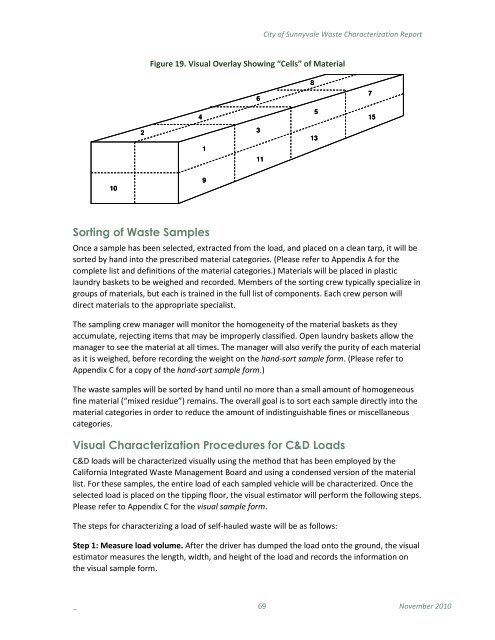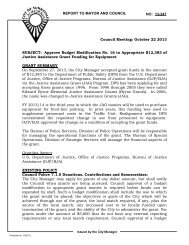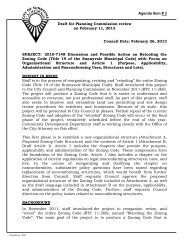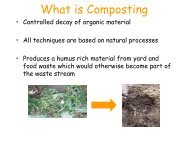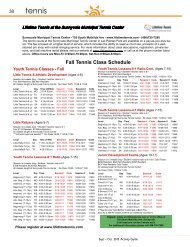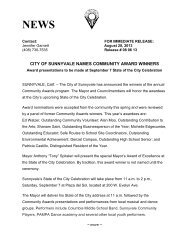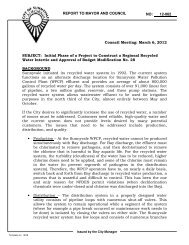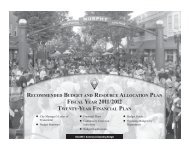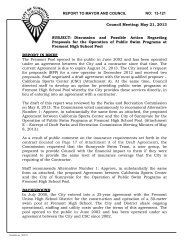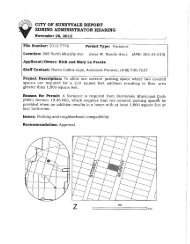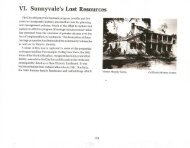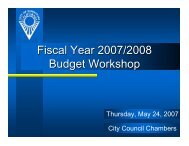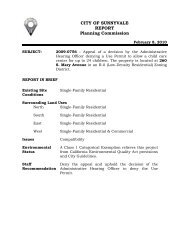City of Sunnyvale Waste Characterization Report
City of Sunnyvale Waste Characterization Report
City of Sunnyvale Waste Characterization Report
You also want an ePaper? Increase the reach of your titles
YUMPU automatically turns print PDFs into web optimized ePapers that Google loves.
10<br />
2<br />
<strong>City</strong> <strong>of</strong> <strong>Sunnyvale</strong> <strong>Waste</strong> <strong>Characterization</strong> <strong>Report</strong><br />
Figure 19. Visual Overlay Showing “Cells” <strong>of</strong> Material<br />
4<br />
1<br />
9<br />
Sorting <strong>of</strong> <strong>Waste</strong> Samples<br />
Once a sample has been selected, extracted from the load, and placed on a clean tarp, it will be<br />
sorted by hand into the prescribed material categories. (Please refer to Appendix A for the<br />
complete list and definitions <strong>of</strong> the material categories.) Materials will be placed in plastic<br />
laundry baskets to be weighed and recorded. Members <strong>of</strong> the sorting crew typically specialize in<br />
groups <strong>of</strong> materials, but each is trained in the full list <strong>of</strong> components. Each crew person will<br />
direct materials to the appropriate specialist.<br />
The sampling crew manager will monitor the homogeneity <strong>of</strong> the material baskets as they<br />
accumulate, rejecting items that may be improperly classified. Open laundry baskets allow the<br />
manager to see the material at all times. The manager will also verify the purity <strong>of</strong> each material<br />
as it is weighed, before recording the weight on the hand-sort sample form. (Please refer to<br />
Appendix C for a copy <strong>of</strong> the hand-sort sample form.)<br />
The waste samples will be sorted by hand until no more than a small amount <strong>of</strong> homogeneous<br />
fine material (“mixed residue”) remains. The overall goal is to sort each sample directly into the<br />
material categories in order to reduce the amount <strong>of</strong> indistinguishable fines or miscellaneous<br />
categories.<br />
Visual <strong>Characterization</strong> Procedures for C&D Loads<br />
C&D loads will be characterized visually using the method that has been employed by the<br />
California Integrated <strong>Waste</strong> Management Board and using a condensed version <strong>of</strong> the material<br />
list. For these samples, the entire load <strong>of</strong> each sampled vehicle will be characterized. Once the<br />
selected load is placed on the tipping floor, the visual estimator will perform the following steps.<br />
Please refer to Appendix C for the visual sample form.<br />
The steps for characterizing a load <strong>of</strong> self-hauled waste will be as follows:<br />
Step 1: Measure load volume. After the driver has dumped the load onto the ground, the visual<br />
estimator measures the length, width, and height <strong>of</strong> the load and records the information on<br />
the visual sample form.<br />
6<br />
3<br />
11<br />
_ 69 November 2010<br />
8<br />
5<br />
13<br />
7<br />
15


